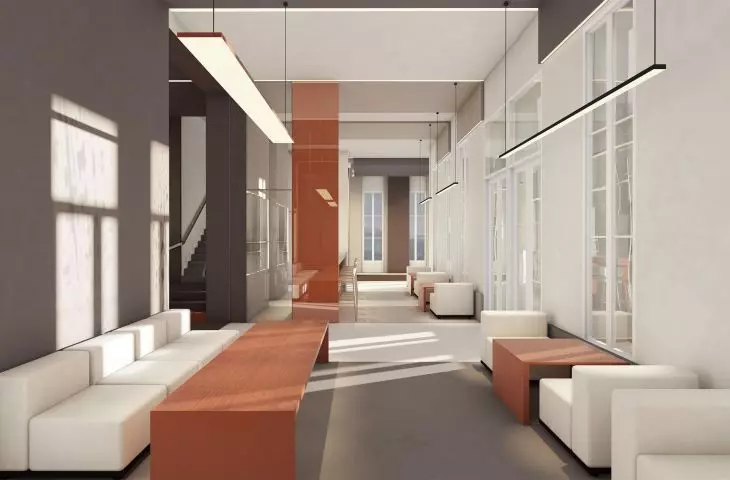Work submitted for the competition
"Best Interior Diploma 2020/2022".
"The world of being-is is a co-world. Being-in is co-being with others." - Martin Heidegger
The adaptation of the space of the former tennis courts into a center serving adolescents on the autism spectrum and a supportive environment is an attempt to create a space relevant to real social needs. Currently, it is estimated that people on the spectrum make up one percent of the population, which on a European scale means five million people. These individuals perceive their existence as suspended on the border of two worlds - their own and the neurotypical world. The created concept of a center surrounded by a sensory garden is therefore to blur the boundaries, teach tolerance and respect for difference, allow autistics to come "out of the shadows." To be a place where one can learn, relax or establish new relationships.
Former sports complex in Bielsko-Biała
photo: Agnieszka Niczyporuk
The center was located on the site of a former sports complex in Bielsko-Biała, located in the vicinity of a park and the Biała River that once divided two urban centers - Bielsko and Biała.
I began my design work by looking at the biological aspects of autism, which find their spatial reference. I was particularly interested in the specific perception of reality from "the detail to the whole", which I wanted to respect, but giving it a broader context. In addition, the need for structuring, taking into account the rhythm, order in the environment of autics determined the appearance of the interior and exterior space.
project architecture of cohabitation, entrance with reception area
© Agnieszka Niczyporuk
A special role in the creation of spaces was played by the senses. Spaces were visually laid out to emphasize given zones, lighting navigates the viewer, textures are pleasant to the touch, and rooms are acoustically isolated. The watercourse introduced into the interior is intended to promote harmony, while the variable type of paving in the sensory garden affects the stimulation of the individual.
First floor with watercourse in the designed building
© Agnieszka Niczyporuk
In turn, the smell and taste of selected plants have a soothing effect on the mood. Special attention was paid to gravitational safety, accentuating differences in levels, using appropriate upholstered furniture fillings to neutralize possible tripping or bumping.
project architecture of coexistence, situation
© Agnieszka Niczyporuk
The overriding goal was to achieve a state of balance in the wards, which is the starting point for therapeutic work. Thus, part of the rooms was designed for active forms of spending time (to stimulate the individual), while the other was intended to promote tranquility (in the case of overstimulated people). The layout of the rooms was determined by access to sunlight, location in relation to the world's sides and the flow of people in the building. The overall finish is characterized by a mild gradation of colors.
cohabitation architecture project, activity room interior
© Agnieszka Niczyporuk
The functional program includes an active zone consisting of a space for group activities (manual, technical classes), an exhibition space, adjacent to which is a café with an exit to the terrace, in summer providing an additional area for relaxation, and an entrance area with a checkroom. The second wing has a meditation zone, a room for sensory activities with adjacent sanitary facilities. On the first floor, generally more intimate, a room for individual classes, a staff area, a meeting or conference space, and a patio are located. The upstairs rooms also have access to a terrace.
interior of the bar
© Agnieszka Niczyporuk
The sensory garden, on the other hand, has been equipped with small architectural objects that relate in their appearance to the interior elements, while their heterogeneous structure filters light and sound coming from the surroundings. The created basin in the central zone is conducive to the realization of group activities, and the surrounding grandstand is to serve as an audience for the pavilion located in the depths, intended for the organization of such events as summer cinema, open-air painting sessions, plays and mini-concerts.
Both the building and the outdoor area have been adapted to the needs of people with mobility disabilities.
Agnieszka NICZYPORUK
Illustrations: © Author





















































